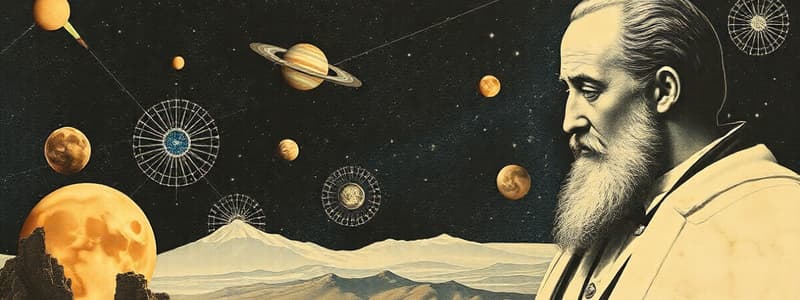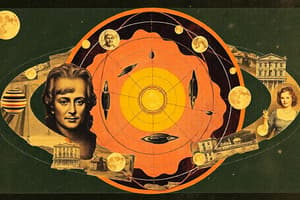Podcast
Questions and Answers
What mathematical method did Isaac Newton employ to demonstrate that Kepler's and Galileo's discoveries stemmed from the same fundamental laws?
What mathematical method did Isaac Newton employ to demonstrate that Kepler's and Galileo's discoveries stemmed from the same fundamental laws?
- Trigonometry
- Algebra
- Geometry
- Calculus (correct)
What is Nicolas Copernicus best known for proposing?
What is Nicolas Copernicus best known for proposing?
- That the Moon is a planet.
- That the Earth is the center of the universe.
- That the Sun is at the center of the solar system. (correct)
- That the stars revolve around the Earth.
According to Copernicus's model, what revolves around the Sun?
According to Copernicus's model, what revolves around the Sun?
- The Earth and other planets. (correct)
- Only the Earth and Moon.
- The entire universe.
- Only the Earth.
What was a major shift in perspective caused by Copernicus's theory?
What was a major shift in perspective caused by Copernicus's theory?
Copernicus's astronomical model primarily focused on the arrangement of which celestial bodies?
Copernicus's astronomical model primarily focused on the arrangement of which celestial bodies?
Which concept is directly associated with Nicolas Copernicus?
Which concept is directly associated with Nicolas Copernicus?
What uncertainty exists in the depiction of the 'AGHAM' instrument?
What uncertainty exists in the depiction of the 'AGHAM' instrument?
What is the primary classification of the item labeled 'AGHAM'?
What is the primary classification of the item labeled 'AGHAM'?
What kind of additional context would improve understanding of 'AGHAM' instrument?
What kind of additional context would improve understanding of 'AGHAM' instrument?
What characteristic limits comprehension of the 'AGHAM' instrument diagram?
What characteristic limits comprehension of the 'AGHAM' instrument diagram?
What specific attribute of the 'AGHAM' is impossible to determine?
What specific attribute of the 'AGHAM' is impossible to determine?
What was Galileo Galilei known for, according to the information presented?
What was Galileo Galilei known for, according to the information presented?
The text mentions that Galileo's work helped to prove whose statement?
The text mentions that Galileo's work helped to prove whose statement?
Which of the following describes Boccaccio's relationship with Petrarch?
Which of the following describes Boccaccio's relationship with Petrarch?
Based on the presentation, what specific invention aided Galileo in his work?
Based on the presentation, what specific invention aided Galileo in his work?
What is the primary characteristic of the stories that make up Boccaccio's Decameron?
What is the primary characteristic of the stories that make up Boccaccio's Decameron?
What is the name of Boccaccio's most famous work?
What is the name of Boccaccio's most famous work?
What language was used in the presentation to describe Galileo Galilei's accomplishments?
What language was used in the presentation to describe Galileo Galilei's accomplishments?
How many stories does The Decameron include?
How many stories does The Decameron include?
What visual aid is present alongside the text about Galileo Galilei?
What visual aid is present alongside the text about Galileo Galilei?
Which of the following topics is explored in the Decameron?
Which of the following topics is explored in the Decameron?
What mathematical tool did Isaac Newton use to demonstrate fundamental scientific principles?
What mathematical tool did Isaac Newton use to demonstrate fundamental scientific principles?
Upon whose earlier discoveries did Isaac Newton's work primarily build?
Upon whose earlier discoveries did Isaac Newton's work primarily build?
Which area of mathematics was instrumental in Newton's scientific advancements?
Which area of mathematics was instrumental in Newton's scientific advancements?
What is a key characteristic of the phenomena that Newton's work addressed?
What is a key characteristic of the phenomena that Newton's work addressed?
Which of the following best describes Newton's approach to scientific discovery?
Which of the following best describes Newton's approach to scientific discovery?
In what field did Andreas Vesalius make significant contributions?
In what field did Andreas Vesalius make significant contributions?
Andreas Vesalius primarily focused his anatomical studies on what?
Andreas Vesalius primarily focused his anatomical studies on what?
What is a key aspect associated with Andreas Vesalius's work?
What is a key aspect associated with Andreas Vesalius's work?
Which area of study did Andreas Vesalius NOT contribute directly to?
Which area of study did Andreas Vesalius NOT contribute directly to?
What detail is emphasized regarding Vesalius's study of the human body?
What detail is emphasized regarding Vesalius's study of the human body?
What significant discovery is attributed to William Harvey?
What significant discovery is attributed to William Harvey?
Which visual elements can be found in the presentation about William Harvey?
Which visual elements can be found in the presentation about William Harvey?
What decorative elements accompany the presentation on the television?
What decorative elements accompany the presentation on the television?
What object is visible on the surface in front of the TV during the presentation?
What object is visible on the surface in front of the TV during the presentation?
Which of the following statements about William Harvey is incorrect?
Which of the following statements about William Harvey is incorrect?
What is the central idea of Copernicus's heliocentric model?
What is the central idea of Copernicus's heliocentric model?
Which statement accurately describes Copernicus's view of planetary motion?
Which statement accurately describes Copernicus's view of planetary motion?
Which concept was a significant change introduced by Copernicus?
Which concept was a significant change introduced by Copernicus?
What was a common misconception prior to Copernicus's theory?
What was a common misconception prior to Copernicus's theory?
What did Copernicus's heliocentric model primarily challenge?
What did Copernicus's heliocentric model primarily challenge?
What did Galileo Galilei invent that contributed to astronomical studies?
What did Galileo Galilei invent that contributed to astronomical studies?
What was the main purpose of Galileo's telescope?
What was the main purpose of Galileo's telescope?
Which significant figure's theories did Galileo Galilei aim to investigate using his telescope?
Which significant figure's theories did Galileo Galilei aim to investigate using his telescope?
Which of the following instruments is NOT associated with Galileo Galilei?
Which of the following instruments is NOT associated with Galileo Galilei?
What was the technological impact of Galileo's invention on scientific observation?
What was the technological impact of Galileo's invention on scientific observation?
Flashcards
AGHAM
AGHAM
A labeled musical instrument likely depicted in a blurry diagram.
Musical Instrument
Musical Instrument
An object designed to produce sound for music.
Diagram
Diagram
A simplified drawing showing the structure or function of something.
Blurry
Blurry
Signup and view all the flashcards
Visual Information
Visual Information
Signup and view all the flashcards
Nicolas Copernicus
Nicolas Copernicus
Signup and view all the flashcards
Heliocentric Model
Heliocentric Model
Signup and view all the flashcards
Solar System
Solar System
Signup and view all the flashcards
Planets Revolving
Planets Revolving
Signup and view all the flashcards
Copernican Revolution
Copernican Revolution
Signup and view all the flashcards
Galileo Galilei
Galileo Galilei
Signup and view all the flashcards
Telescope
Telescope
Signup and view all the flashcards
Heliocentrism
Heliocentrism
Signup and view all the flashcards
Copernicus
Copernicus
Signup and view all the flashcards
Scientific Method
Scientific Method
Signup and view all the flashcards
Giovanni Boccaccio
Giovanni Boccaccio
Signup and view all the flashcards
Decameron
Decameron
Signup and view all the flashcards
Friendship with Petrarch
Friendship with Petrarch
Signup and view all the flashcards
Humorous stories
Humorous stories
Signup and view all the flashcards
Cultural impact of Decameron
Cultural impact of Decameron
Signup and view all the flashcards
Calculus
Calculus
Signup and view all the flashcards
Kepler's Laws
Kepler's Laws
Signup and view all the flashcards
Integration of discoveries
Integration of discoveries
Signup and view all the flashcards
Laws of Motion
Laws of Motion
Signup and view all the flashcards
William Harvey
William Harvey
Signup and view all the flashcards
Circulation of Blood
Circulation of Blood
Signup and view all the flashcards
Discovery
Discovery
Signup and view all the flashcards
Physician
Physician
Signup and view all the flashcards
Presentation
Presentation
Signup and view all the flashcards
Andreas Vesalius
Andreas Vesalius
Signup and view all the flashcards
Anatomy
Anatomy
Signup and view all the flashcards
Seven Structures of the Human Body
Seven Structures of the Human Body
Signup and view all the flashcards
Human Body
Human Body
Signup and view all the flashcards
Study of Anatomy
Study of Anatomy
Signup and view all the flashcards
Galileo's Telescope
Galileo's Telescope
Signup and view all the flashcards
Purpose of the Telescope
Purpose of the Telescope
Signup and view all the flashcards
Copernican Theory
Copernican Theory
Signup and view all the flashcards
Galileo's Contribution
Galileo's Contribution
Signup and view all the flashcards
Celestial Investigation
Celestial Investigation
Signup and view all the flashcards
Sun-centered model
Sun-centered model
Signup and view all the flashcards
Planets
Planets
Signup and view all the flashcards
Revolution in astronomy
Revolution in astronomy
Signup and view all the flashcards
Isaac Newton
Isaac Newton
Signup and view all the flashcards
Contributions
Contributions
Signup and view all the flashcards
Kepler
Kepler
Signup and view all the flashcards
Galileo
Galileo
Signup and view all the flashcards
Study Notes
Topic: Agham
- The image shows a title, likely a topic, related to science.
- The title is "Agham" which translates to Science.
- The image doesn't contain any further details regarding the specific subject matter of agham.
Studying That Suits You
Use AI to generate personalized quizzes and flashcards to suit your learning preferences.




